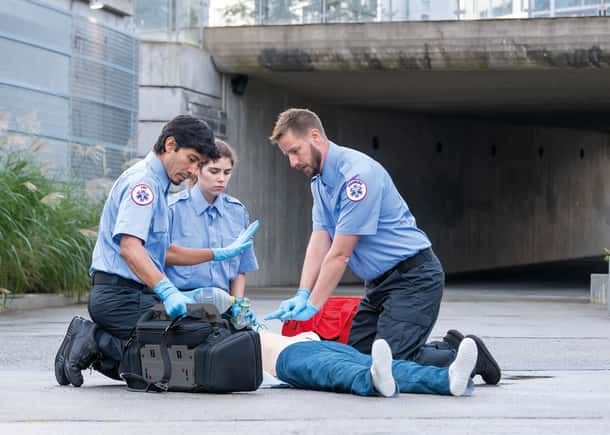5 Tips for High-Performance CPR Excellence
Strong teamwork can turn training into survival.

Strong teamwork can turn training into survival.

- Mike Helbock, M.I.C.P, NR-P
Division Chief – EMS Training, Seattle/King County Medic One (ret.), Faculty – Seattle/King County Resuscitation Academy1

The quality of CPR delivered during a resuscitation has a major impact on survival.2
When it comes to quality CPR training, many instructors focus on perfecting the technical skills of individual rescuers - but focusing on rescuers’ performance as a team can also affect the quality of the CPR delivered.3 High-performance CPR, or “letter perfect” CPR, centers on evidence-based, individual and team performance metrics.4
In this article, we explore five tips to help you implement high-performance CPR training.

If you’re already familiar with high-performance CPR, skip to the next section. But many systems are still trying to educate their staff on the topic – so here is a brief summary.
CPR is life-critical – but it’s inherently inefficient. It provides just 10% to 30% of normal blood flow to the heart, and only 30% to 40% of normal blood flow to the brain.5 That’s why quality matters. Considering this reality emphasizes the urgency behind the need to make CPR as efficient as possible to increase its effectiveness and buy more time.
This is the intent behind high-performance CPR.
- Ann Doll
Executive Director, Resuscitation Academy Foundation
CPR quality contributes to the extensive variability of survival between and within systems of care.6 High-performance CPR can make drastic improvements to survival rates. King County, WA saw a 50% improvement in discharged survival in the first year following high-performance CPR training,7 and their survival rates are among the highest in the world.8
Now that you’re up to speed on the importance of high-performance CPR, read these five tips for training success.

Role clarity is the backbone of high-performance CPR. When everyone knows their position before the call comes in, precious seconds aren’t wasted on scene.
Allow teams to practice their roles repeatedly until the choreography feels like second nature. Without this kind of repetition, even experienced providers can slip into hesitation or overlap responsibilities when the pressure is on.
A manikin like Resusci Anne QCPR provides the realism needed to make role rehearsal effective. With anatomically accurate features, team members can practice their responsibilities in a lifelike environment that mirrors real emergencies. They'll build the muscle memory and coordination that translate directly to better performance in actual resuscitation events.

It may seem obvious that measurement is key to improvement – but this holds especially true for CPR, as it is nearly impossible to judge CPR quality by look or feel alone.
Key parameters of high-quality CPR include:
Precise measurement and feedback promotes continuous improvement of both individual and team CPR skills.
- David Weed
Community Services Officer for Woodinville Fire and Rescue in King County, WA11
The specific high-quality CPR parameters make using a reliable measurement tool a must. The QCPR app delivers Quality CPR (QCPR) feedback directly to your tablet. And, new pro features are now available at no added cost. You can:

High-performance CPR rarely happens in a controlled, predictable environment. Teams need to be ready for cramped apartments, crowded public spaces, or complex multi-patient incidents. Training should mimic this variety so providers can adapt their workflow, communication, and timing under any circumstance.
By rotating through multiple types of environments and scenarios, teams build adaptability while reinforcing high-quality compressions, efficient shock delivery, and smooth communication – even when the environment isn’t ideal.
The Monitor by Laerdal is a portable and flexible solution that can function as a defibrillator, a patient monitor, or a ventilator. This provides the versatility for learners to master high-quality CPR, react to changes in vital signs, interpret ECGs, and perform defibrillation and pacing across a range of settings.

Effective defibrillation training will help teams move seamlessly from rhythm recognition to shock delivery without unnecessary compression pauses. Repeated practice builds confidence and reinforces the choreography that makes high-performance CPR so effective in the field.
Using realistic equipment allows learners to rehearse pad placement, energy selection, and shock delivery under the same pressures they’ll face in real emergencies.
The ShockLink device connects to most commonly-used defibrillators, allowing you to use your own live defibrillator for training. Pair it with Resusci Anne QCPR with AED skin and a feedback device like SimPad PLUS with SkillReporter will give you a fully integrated experience. Rhythms will automatically be sent to the defibrillator when pads are placed correctly. The shock information will be included in your QCPR feedback (real-time and post-event).

Experts agree that debriefing is a fundamental component of resuscitation education that drives performance improvement.12 Optimal feedback and debriefing practices have been shown to promote acquisition and retention of skills and even affect patient outcomes.13
The most valuable learning happens after the scenario ends. Reviewing exactly what went well and what slowed things down turns a run-through into lasting skill improvement. Without this step, teams risk carrying the same inefficiencies into the next scenario – or the next real call.
Video-assisted debriefing brings a powerful layer of reflection to high-performance CPR training. By capturing real-time performance, teams can review exactly how roles were executed, how well communication flowed, and where delays or inefficiencies occurred.
- Ed Biebel
Clinical Simulation Manager, Rowan College at Burlington County

Read Ed’s full story: Preparing Paramedic Students with Video-Assisted Debriefing at Rowan College
SimCapture for EMS can help teams see how they move together and where adjustments could make them faster and smoother. Use it to capture scenario footage and annotate key moments to facilitate debriefing. SimCapture’s easy-to-use reports help you analyze team performance and communication and identify gaps or areas of improvement.